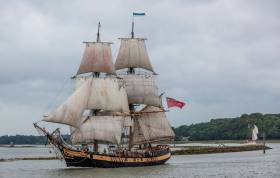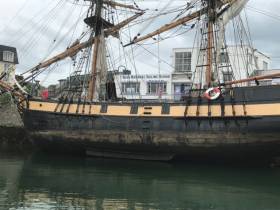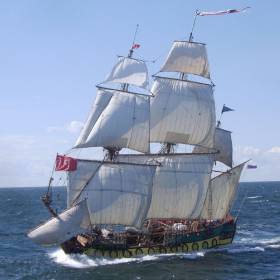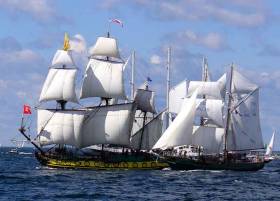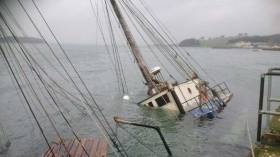Displaying items by tag: Tall ship
The Irish Maritime Festival sails back into Drogheda Port this weekend (Saturday 10th and Sunday 11th June) bringing its largest ever flotilla of Tall Ships including the Russian frigate Shtandart and the Earl of Pembroke.
Keen photographers can see the ships muster at the mouth of the Boyne (Maiden Tower, Mornington) at 11.30am on Friday morning, 9th June. The parade of sail will reach Drogheda’s iconic Viaduct around noon. Donor’s Green on the north strand is the ideal vantage point for photographers at this time.
Maritime highlights for 2017 include:
• The annual Boyne Swim takes place on Saturday 10th June. Starting at 12.50hrs, this challenging 2.7km tidal river swim is a hard fought contest for glory. Cheer on the 200+ swimmers as they race past the Tall Ships docked at the Maritime Festival.
• Perhaps the world’s most iconic fiddle player, Steve Wickham, will officially launch Fiddle Case Pier, a new pier that will allow recreational vessels to sail up and berth on the River Boyne.
• Howth Yacht Club have, once again, joined forces with Drogheda Port to stage the Howth-Drogheda Yacht challenge. Starting from Howth at 10.00hrs on Saturday, yachts are expected to arrive in Drogheda by 14.00hrs. This fun-filled race challenge is always followed by a weekend of fun and festivities for sailors visiting Drogheda.
• The largest ever crew of trainees to take part in the Drogheda Sail Training Bursary. The Bursary provides valuable opportunities for young people (16 and 17 years old) from the Louth and Meath to experience sailing. Exposure to sail training opens up career and leisure opportunities for life.
The award-winning festival, now in its fifth year aims to promote Maritime history and heritage in the north east. The festival also boasts a fabulous on-shore programme including live music, kids stage, food tastings and cookery demos and a whole lot more. Hosted by Louth County Council and Drogheda Port Company, the Festival is proudly sponsored by Virgin Media. Visit MaritimeFestival.ie for the full festival programme.
INSS Welcomes Tall Ship Phoenix to Dun Laoghaire Harbour
The Irish National Sailing School (INSS) welcomed their old friends on the Tall Ship Phoenix back to Dun Laoghaire Harbour today.
The Phoenix, operated by film production facility Square Sail, participated in last weekend's Dublin Port Riverfest on the River Liffey.
The two–masted brig is currently along side at the West Pier in Dun Laoghaire for maintenance work to bottom timbers.
'It's 20 years exactly since INSS and Square Sail worked together on the D–Day beach scenes on the film 'Saving Private Ryan' in Wexford', INSS's Alistair Rumball told Afloat.ie
INSS provide marine production faciliies in Ireland and Rumball is currently working on the TV smash–hit The Vikings, as Afloat.ie previously reported.
Russian Tall Ship 'Shtandart' Among a New Fleet Visiting Drogheda Port for the Irish Maritime Festival
Drogheda Port's Captain Martin Donnelly have invited a wonderful new fleet of ships to visit Drogheda for the Irish Maritime Festival 2017 on 10-11th June.
“The visiting ships are the focal point of The Irish Maritime Festival and it is always wonderful to see people of all ages climbing aboard to explore these magnificent vessels. It’s so important that we offer a selection of ships each year to interest and excite our audience and this is our biggest offering of Tall Ships yet.” explains Capt. Donnelly, Harbourmaster of Drogheda Port.
He was speaking this week as he unveiled the line-up of ships visiting Drogheda this year.
“We’re delighted to welcome the Brian Boru, a sail training vessel based in Waterford. Drogheda’s first crew of sail trainees will arrive at the end of their voyage on Friday while the second crew will depart Drogheda on Monday.”
Perhaps the most impressing of all the ships sailing into Drogheda this summer will be the “Shtandart”. Commissioned by Tsar Peter I of Russia in 1703, the modern day “Shtandart” is an exact replica. Built in 1999, this magnificent 128m long vessel carries 10 officers and 30 trainees. The elegant masts will play host to the Peter Pan aerial acrobatic show during the Irish Maritime Festival.
He continued “We’ve an unusual new addition to the festival for 2017. Coming into service in 1965, the motor tug “Brocklebank” served for 23 years as a tug assisting cargo ships, passenger liners and naval vessels to their berths. She really has been a workhorse of the maritime industry. Now, in retirement, she resides at Albert Dock as part of the Liverpool Maritime Museum and we’re delighted that she’s making the journey to Drogheda for the festival.”
Captain Donnelly concluded “Others visiting Drogheda for the festival include “La Malouine”, an elegant Polish brigantine, the Danish schooner “Soteria” and the stunning “Phoenix”. “The Earl of Pembroke” a magnificent three-masted sailing ship will also dock at Drogheda Port and play host to the Stowaway Sessions, two intimate music gigs on Friday and Saturday night.”
Keep your eye out for the beautiful tall sailing ship “Maybe”, which was built in 1929, which will make a short appearance with another crew of sail trainees. This year there is a big focus on sail training at the festival with no less than three vessels carrying trainees. A special gathering and presentation is taking place at 6.00pm on Friday 9th June at Millmount Tower. Anyone interested in future voyages is welcome to attend.
Find out more about each of the ships by visiting www.MaritimeFestival.ie/Ships. The Irish Maritime Festival is hosted by Louth County Council and Drogheda Port Company in association with Virgin Media. Find out more by visiting www.MaritimeFestival.ie and follow on Facebook and Twitter for competitions, news and festival updates.
A New Tall Ship For Ireland? Would it Be Worth The Trouble?
As we move into March each year, throughout Ireland Tall Ships enthusiasts will wistfully recall that it was in March 1981 that Ireland finally commissioned her own Tall Ship, a national flagship worthy of our aspirations, the Jack Tyrrell-designed and Arklow-built 84ft brigantine Asgard II writes W M Nixon.
She gave years of excellent service and introduced young people from all backgrounds and every part of the country to the complete sail training experience at its very best. Yet although she was officially within the remit of the Department of Defence, in times of government expenditure cutbacks, the very existence of such an exotic creature in the amidst the workaday problems of running organisations with a military emphasis could be problematic.
Under a succession of talented and dedicated skippers with a small but devoted permanent crew, Asgard II was run in an efficient yet distinctly non-military, non-bureaucratic way. Even if at times it was done on a shoestring, it was all kept working, appearances were kept up with the vessel maintained by the crew, and the seemingly free-style system of command, while it had a core of disciplined pure steel at its heart, worked well to create a happy ship.
Nevertheless it could be argued that the unique and complex problems of running a small national sail training ship and her programme were about as far as could be from the instinctive abilities and traditional approach of the Irish Public Service mindset. But that said, the Irish public service has broad shoulders. There may not always have been total enthusiasm within it for having anything to do with running Asgard II. But it was always there in their In-tray, and they got on with it, with secretaries to Coiste an Asgard tending to give service way over and above the requirements of duty.
Yet being a Government-run ship, inevitably the viewpoint of whoever was Minister for Defence at the time affected the attitude to the Asgard programme. The realities of democracy intervened. At a national level, even in coastal constituencies, few if any votes were won or lost over whether the local TD vociferously supported the Asgard II sail-training programme. And if the current Minister for Defence happened to represent an inner-city constituency with little if anything in the way of deeply-engrained maritime traditions, Asgard II was way down the list of priorities.
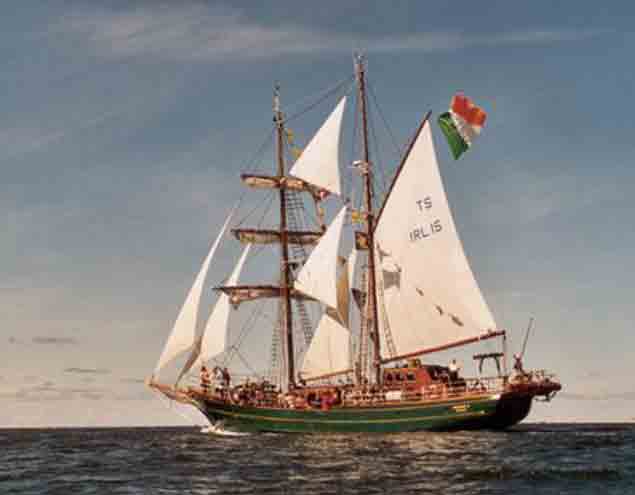 Thanks to devoted bos’uns and crew, Asgard II was always looking her best even when age was creeping up on her.
Thanks to devoted bos’uns and crew, Asgard II was always looking her best even when age was creeping up on her.
But she could be kept going – just - thanks to the ability of those running her to stretch resources to the limit and beyond. Yet with every passing season, the longterm problems were increasing. By the time she was sailing her 25th season in 2005, there were those who argued that a traditional wooden hull, with its single-skin planked construction, was no longer in compliance with increasingly complex regulations which required double-skin construction in a passenger-carrying boat, but Asgard II – with her limited number of trainees - was still able to pass regulations as a cargo-carrying vessel.
Then too, in the late noughties, Asgard was looking her very best with a devoted skipper and an extremely able bo’sun. But skilled painting, word-class varnishwork, and the necessary provision of a new and highly-visible set of immaculate spars, disguised the fact that if Coiste an Asgard had been given the funds to provide a replacement hull, the latest set of regulations would have insisted that it be double-skin. That in turn would have led to a raging public debate between those who would insist that Asgard III must be built in wood, and those who would reasonably point out that a double-skin wooden hull – with a safety gap between the skins as required by regulations – would be very space-consuming in a little ship which, even in her single-skin version, was already very crowded within her hull, and thus steel or even aluminium would provide the best way to go.
It all became very academic on September 8th 2008, when Asgard II sank off Belle Ile in the Bay of Biscay while on passage with a full crew of trainees from Falmouth in Cornwall towards the French port of La Rochelle. It started to happen shortly after midnight, and as she sailed along in reasonably pleasant late summer conditions, no-one on board had seemed aware of any impact with a submerged hazardous object, such as a container, which might have caused this sudden ingress of water.
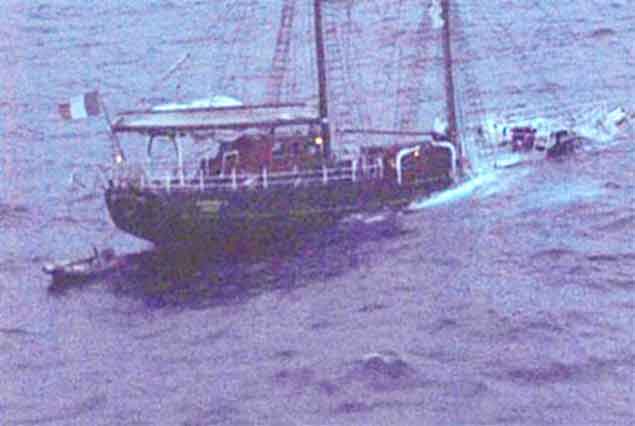 Monday, September 8th 2008
Monday, September 8th 2008
But it became such that the ship’s pumps couldn’t cope, and the captain’s first duty was to his trainees – it would have been irresponsible to spend precious time in the small hours of the morning calling up any ship which might happen to be in the neighbourhood, in the hope that she might have transferrable pumping systems which would have helped alleviate the problem.
The seamanlike thing was to declare the ship a hulk, and arrange her abandonment in an orderly manner. The only setback which arose in this action was the collapse of the floor in one of the large liferafts – a liferaft which had only recently been re-certified – but the people on it were transferred to other liferafts, and in due course the local lifeboat arrived and took everyone to Belle Ile while Asgard sank with a certain quiet dignity, and took up a position sitting on the seabed in 84 metres of water.
There were immediate calls for her salvaging as soon as possible, to be followed by full restoration and a resumption of sail training duties. But the senior officer of the Naval Service involved in the issue put it all in a harsh but necessary perspective: “Would you like your children to go to sea as trainees in a ship which has sunk in this way” he quietly asked, “when, however good the restoration, it is still the restoration of a vessel which inexplicably sank like this?”.
For however much you try to read into the official report, its results are not totally conclusive, and the reality is that the Asgard II sank, and sank quite quickly, after an impact of which no-one was aware. It’s very likely the sinking would not have happened had she been double-skinned. But any attempts to make a raised and restored Asgard II into a double-skinned vessel would have been an absurd waste and misdirection of resources.
Be that as it may, by this time, the Irish economy was in complete free-fall off a very high and steep economic cliff, and although the loss of the Asgard II was assuaged eventually by an insurance payout of €3.8 million, it was only within the sail training community that anyone protested against the transfer of these funds to the Department of Finance at a time when the national economy was on its knees with the Troika bail-out.
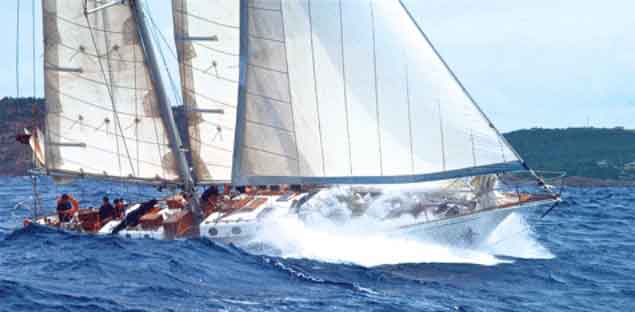 Spirit of Oysterhaven is licensed to carry 12 trainees
Spirit of Oysterhaven is licensed to carry 12 trainees
In fact, the Government – for the time being at any rate – was quietly exiting the sail training arena, and in 2011 all the remaining assets and functions of Coiste an Asgard were transferred to a new non-Governmental organisation, Sail Training Ireland, which set to work to find berths for Irish trainees on other ships in an international network which, partly thanks to the very favourable reputation which Asgard II had established for herself during her 28 busy years, has been working well as they’ve also brought in “private enterprise” training ships such as Oliver Hart’s yacht-like 70ft schooner Spirit of Oysterhaven, which has been awarded the Sail Training International Small Vessel Award for 2016, a really notable achievement in a crowded field.
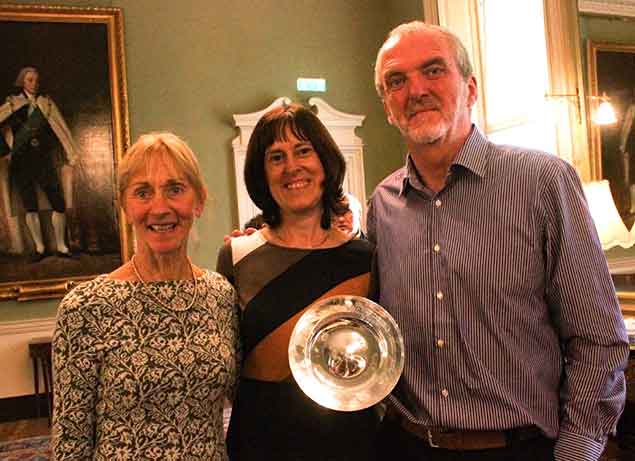 Kate Hart, Sinead Hurley and Gary Davis of Spirit of Oysterhaven. Winner of Sail Training International Small Vessel Award for 2016.
Kate Hart, Sinead Hurley and Gary Davis of Spirit of Oysterhaven. Winner of Sail Training International Small Vessel Award for 2016.
 While sail training should be mainly about sailing, from time to time the vessels involved have to manoeuvre under power in very small harbours. Spirit of Oyserhaven’s lines are of special interest, as they reveal the designer has retained a straight leading edge on the rudder, thereby optimising the control benefit of propeller thrust even though the propeller is in an aperture in the long-keel hull.
While sail training should be mainly about sailing, from time to time the vessels involved have to manoeuvre under power in very small harbours. Spirit of Oyserhaven’s lines are of special interest, as they reveal the designer has retained a straight leading edge on the rudder, thereby optimising the control benefit of propeller thrust even though the propeller is in an aperture in the long-keel hull.
But inevitably a couple of years after the loss of Asgard, when her complete demise was finally accepted, voices were being raised in support of returning some day to the position of Ireland having her own sail training ship. It has to be said that these were for many years just a few voices crying in a wilderness, for in the near decade since Asgard II sank, Ireland has been a complete disaster area for tall ships and sail training vessels.
The litany of disaster is unbelievable. The only redeeming feature is that in a great tapestry of sinkings and groundings and the striking of rocks, not one life has been lost. But many dreams and careers have been utterly destroyed.
Appropriately, we’d had a rehearsal on RTE way back in 2003, when the traditional gaff schooner Carrie involved in the reality TV series Cabin Fever managed to come ashore on Tory Island, and soon broke up for the delectation of millions of viewers worldwide, with the whole sorry episode being on a loop on the screen in many a harbourside bar.
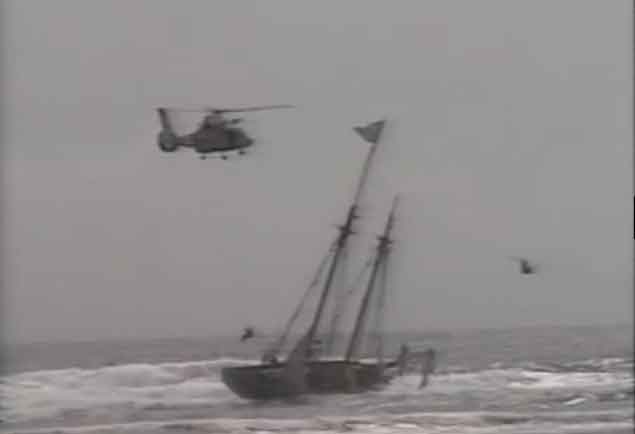 A video grab from RTE News of the Cabin Fever Ship aground
A video grab from RTE News of the Cabin Fever Ship aground
Then, even before the Asgard II story had been laid to rest, in 2010 the Northern Ireland Sail Training ship, the 80ft Oyster ketch Lord Rank, managed to impale herself on a rock northwest of Ballycastle in Rathlin Sound on the Antrim coast. Once again the incident got even more publicity than would have normally been expected, as they had a team from Downtown Radio on board to transmit a broadcast.
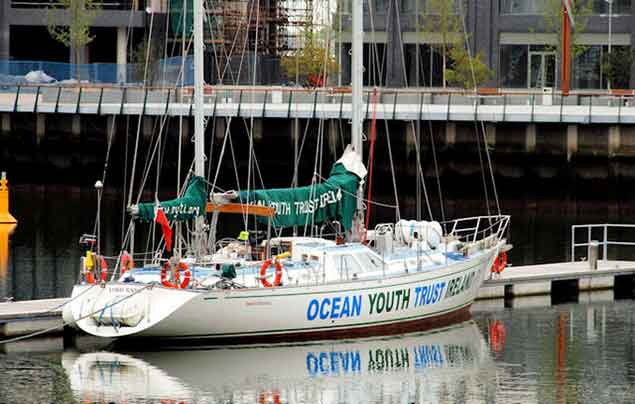 The Northern Ireland 80ft ketch Lord Rank sank within two years of Asgard II going down
The Northern Ireland 80ft ketch Lord Rank sank within two years of Asgard II going down
But a Bermudan rigged ketch on an isolated rock doesn’t make for nearly as spectacular a wreck as a proper Tall Ship destroying herself in against a cliff, and this epic was provided in 2013 when it was demonstrated that the road to hell is paved with good intentions.
Ireland was barely getting her nose above water after the bail-out, and in order to get things moving again on the tourism front – for who would want to be a tourist in a country in the depths of economic and psychological depression? – the Department for Tourism set up 2013 to be the Year of the Gathering, when people of Irish descent worldwide would be encouraged to return home for holidays in the Old Sod, the land of their ancestors.
Whether it was a bright idea or not is neither here nor there, as funds were lapped-up in order to pay for “Gatherings” such as family weddings. But the fact is that generally it was announced with little enough time to spare for anyone, other than those catering for people who make last-minute short-break holiday decisions, to make proper plans. Thus with only months to go, the Irish Sailing Association co-opted the Cruising Association of Ireland to put together a Gathering Cruise for visitors from Dublin Bay to West Cork, and while it attracted a turnout, the mood became more optimistic as they proceeded along the south coast, as it was learned that at Oysterhaven the little fleet would be joined by the 137ft Dutch Tall Ship Astrid, which at a stroke would maybe double the number of people taking part.
But the Irish weather and the fates in general would not let you get away with such a serendipitous turn of events. Following the Oysterhaven meet, the fleet were to parade round to Kinsale. But it was a dirty day of an onshore wind, and the old Astrid would need the help of her small auxiliary engine if she was going to make a suitably impressive entrance to Kinsale close by the cliffs.
Unfortunately, at a port of call earlier in her voyage from the Netherlands, Astrid had mistakenly had some fresh water put into her diesel tank. Though every effort had been made to remove it, the fuel was still contaminated and the engine cut out at the absolute crucial moment of rounding the headland immediately east of Kinsale.
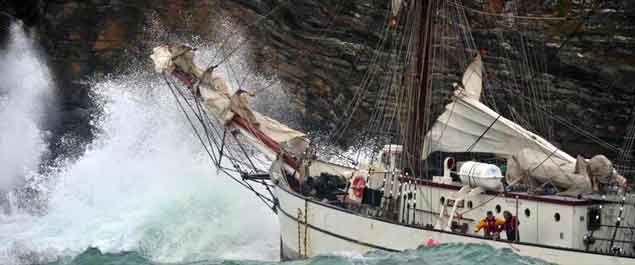 Death in slow motion. Astrid onto the cliffs outside Kinsale
Death in slow motion. Astrid onto the cliffs outside Kinsale
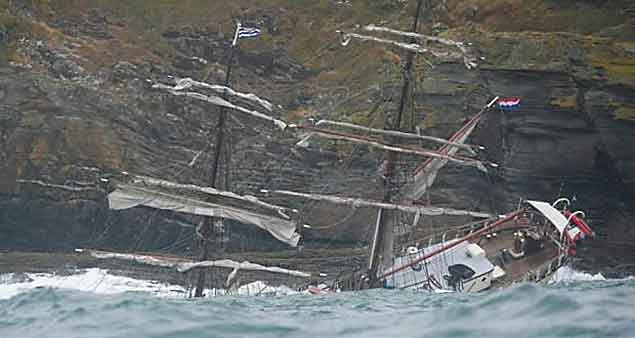 All hope gone. Astrid’s death throes.
All hope gone. Astrid’s death throes.
Unlike the Asgard II’s graceful departure, poor old Astrid had a long and lingering death in against those cliffs. It was a salutary lesson for everyone, for until then we’d tended to look to the Dutch as the very exemplars of a properly-run, indeed closely-regulated maritime nation. Yet it emerged that neither Astrid nor some of those involved in running her were properly certified to be taking trainees to sea.
We’re always told that we in Ireland are too lax in implementing European maritime law, working on the old Chinese saying that the mountains are very high, and the Emperor is far away. Admittedly, apart from Snowdonia in Wales, there are no mountains between Ireland and Brussels. But even so, things seem to be the other way round in any case – the nearer you get to the entre of power, the more relaxed is the observation of “petty” regulations.
In 2013 I’d already seen a demonstration of this when a large Dutch contingent arrived in Dublin as part of the Old Gaffers Association Golden Jubilee Cruise in Company. When we were in Dublin port, up the river came a Dutch character boat captain and his little dog in their tiny dinghy, and a classic Seagull outboard on the stern spluttering all sorts of pollution at a time when everyone else in Europe seemed obsessed with the compliance of regulations about changing to much heavier pollution-reducing four strokes, or making the big move to electric outboards.
 One man and his dog. In 2013, a Dutch Old Gaffer cruising the Liffey had scant regard for Directives from Brussels about doing away with old polluting outboards. But at least they were wearing lifejackets…..Photo: W M Nixon
One man and his dog. In 2013, a Dutch Old Gaffer cruising the Liffey had scant regard for Directives from Brussels about doing away with old polluting outboards. But at least they were wearing lifejackets…..Photo: W M Nixon
So all is not as it seems at the heart of Europe. And after the Astrid disaster those who might have though of using the highly-regarded Dutch marine industry as the source of a new vessel had to undertake further research until they were once again certain it was still the right thing to do.
But equally, after the loss of the Carrie, the Asgard II, the Lord Rank, and the Astrid, and after it had emerged that it was simply too costly to keep the Jeannie Johnston in Dublin and the Dunbrody in New Ross in certified condition as seagoing tall ships, instead of just using them as permanently-berthed visitor attractions, there inevitably has emerged a quiet but real body of opinion which reckons that Ireland having the luxury her own sail training tall ship simply isn’t worth the hassle.
 The Dutch ship Morgenster. Should we continue to send her a regular supply of trainees to save ourselves the trouble of running our own tall ship?
The Dutch ship Morgenster. Should we continue to send her a regular supply of trainees to save ourselves the trouble of running our own tall ship?
After all, Sail Training Ireland – now with Darragh Sheridan as CEO after Michael Byrne has moved on to fresh fields after several successful years – is running very smoothly in placing trainees in other European ships, with the Dutch vessel Morgenster in particular proving so popular that she is now almost honorary Irish.
As the STI programme has developed, well-wishers and organisations such as the Irish Cruising Club are finding it an attractive propositions to provide bursaries for young people to go to sea in a proper international tall ships situation through the STI’s current setup. It’s neat, tidy and manageable. And when winter comes, it’s not our concern whether or not the Morgenstern, and other ships that we in Ireland use, such as the splendid Europa, have to undergo a major refit or instead get themselves out to the Canaries for a profitable winter programme.
Thus as ever it was heartening to attend STI’s annual awards ceremony in Dublin’s Mansion House, and share the enthusiasm of an enormous diversity of young people each of whom had responded in their own favourable way to the Tall Ships experience.
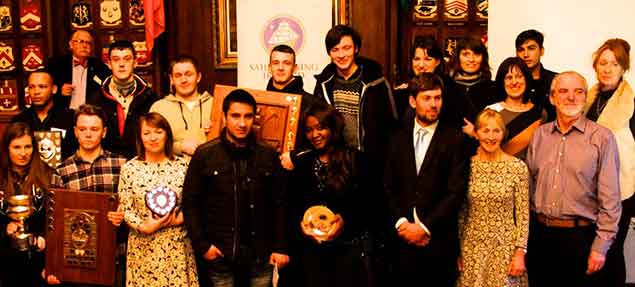 All the award winners at this year’s Sail Training Ireland ceremony in the Mansion House.
All the award winners at this year’s Sail Training Ireland ceremony in the Mansion House.
 Presentation of the Cork Life Centre-Asgard Award with (left to right) Sara Mason & Daragh Sheridan of STI, MC Marcus Connaughton, Commodore Hugh Tully, Flag Officer Commanding Naval Service, and Dublin City Councillor Ruairi McGinley presenting the award to Stuart Barry, Danny O’Keeffe, William Cooper, and Colm O’Brien
Presentation of the Cork Life Centre-Asgard Award with (left to right) Sara Mason & Daragh Sheridan of STI, MC Marcus Connaughton, Commodore Hugh Tully, Flag Officer Commanding Naval Service, and Dublin City Councillor Ruairi McGinley presenting the award to Stuart Barry, Danny O’Keeffe, William Cooper, and Colm O’Brien
 Nathan Howard (left) representing Tim Baker of Belfast, the awardee for Outstanding Achievement, with Seamus McLaughlin, Chairman of Sail Training Ireland
Nathan Howard (left) representing Tim Baker of Belfast, the awardee for Outstanding Achievement, with Seamus McLaughlin, Chairman of Sail Training Ireland The STI Outstanding Contribution award goes to Victor Springbok (right) with (left to right) Sara Mason & Daragh Sheridan of STI, Commodore Hugh Tully and Cllr Ruairi McGinley
The STI Outstanding Contribution award goes to Victor Springbok (right) with (left to right) Sara Mason & Daragh Sheridan of STI, Commodore Hugh Tully and Cllr Ruairi McGinley
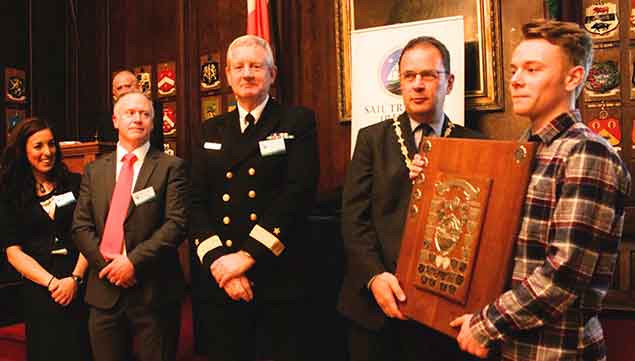 STI Trainee of the Year Ross Moore (right) with (left to right) Sara Mason, Daragh Sheridan, Commodore Hugh Tully, and Cllr Ruairi McGinley.
STI Trainee of the Year Ross Moore (right) with (left to right) Sara Mason, Daragh Sheridan, Commodore Hugh Tully, and Cllr Ruairi McGinley.
But then you couldn’t help but notice that in the Mansion House a popular guest, to whom everyone seemed to relate, was Neil O’Hagan, of the Enda O’Coineen-inspired Irish Atlantic Youth Trust. Their purpose is the creation of an all-island Irish Sail Training Ship, a 140ft three-masted barquentine based on the proven Spirit of New Zealand, and built in steel in the Netherlands by reputable designers and builders, while keeping open the option of having her builders provide a kit which can then be assembled here to become a ship built in Ireland.
To work, the project would need a considerable level of Governmental input and in Ireland’s always fluid yet somehow also rigid political situation, that is the Great Unknown. The Atlantic Youth Trust has offices in Dublin and Belfast to deal directly with Government even if the island’s real maritime capital is Cork, but resolving that will be another day’s work.
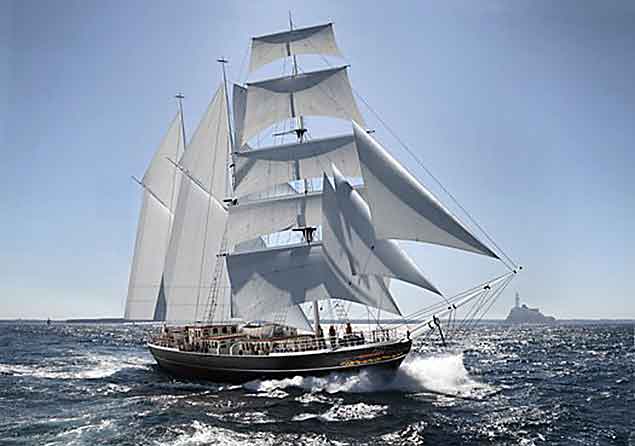 The vision. Concept image for the barquentine-rigged 40-metre Tall Ship proposed by the Atlantic Youth Trust
The vision. Concept image for the barquentine-rigged 40-metre Tall Ship proposed by the Atlantic Youth Trust
As it is, thanks to the influence of leaders such as Chairman Lord Glentoran, the Atlantic Youth Trust arranged a meeting with Peter Robinson MLA, the then First Minister of Northern Ireland. A Tall Ships gathering was shaping up in Belfast (when it happened, it was a notable success) so the mood was good for the delegation, and the First Minister warmly received the idea of a concept which would inevitably involve Government capital expenditure.
And then he made one request. He asked them to go along the corridor and put the idea to Deputy First Minister Martin McGuinness MLA, as that was the way shared power was meant to work. So along they went in some trepidation, and after the usual introductory pleasantries, they outlined the situation and were almost bowled over by Martin McGuinness’s enthusiasm.
Eventually, when they were taking their leave, they asked him why he had leapt at the idea so keenly. He replied that apart from it being a very good idea, it was maybe the first clearcut occasion on which the First Minister had received a proposal, and then without the usually inevitable closeting with his special advisors, had immediately given it a fair wind along to the Deputy Minister. It was how power-sharing was meant to work, but very rarely did.
It was a good start, but there was still a long way to go, for in tandem with their negotiations in the north they had to bring the Dublin government in as an equal partner. Here, the overall response was favourable but the complexities – involving a different structure of Government departments, not to mention all the movements in political mood - made it long hard going.
Meanwhile, there was a by-product which bears out the effect they’d had in the corridors of power in Stormont. Our northern correspondent Betty Armsrong was in Derry for the visit of the Clipper Fleet, in which the city had an entry, and came back enthusing about her new VBF Martin. It turned that while in the Maiden City, she’d spent some time in the company of Martin McGuinness whose enthusiasm for the entire waterborne pageant was total. “Admittedly” said he “the cost of supporting the boat and getting the visit seemed very high when we were being talked into this, but now that it is happening so well, it’s worth every penny”.
It would be ironic if the successful visit of the Atlantic Youth Trust to the office of the Deputy First Minister is in the end only recalled for the fact that Martin McGuinness was an increasingly enthusiastic supporter of major maritime events and projects. But the reality in Government is that the political personnel landscape is now entirely changed both north and south, and we’ll need the dust to settle before we can see where it’s all going.
Yet even as recently as November, Neil O’Hagan reckoned things were looking good, and he’s convinced they’ll come good again in due course. Back in November, despite the turbulence of Brexit, he was getting various government departments north and south and the STI and other bodies nicely lined up for a series of test programmes using the Morgenstern, and then anticipated building on that. A plateau of achievement had been reached, and former Olympic Gold Medallist Lord Glentoran, a visionary chairman but now well into his eighties, felt the time was right to step down and be replaced by noted businessman and experienced sailor Peter Cooke.
 Atlantic Youth Trust in Belfast with (left to right) Neil O’Hagan, Lord Mayor of Belfast Brian Kingston, incoming AYT chairman Peter Cooke, President Enda O’Coineen, and outgoing chairman Lord Glentoran.
Atlantic Youth Trust in Belfast with (left to right) Neil O’Hagan, Lord Mayor of Belfast Brian Kingston, incoming AYT chairman Peter Cooke, President Enda O’Coineen, and outgoing chairman Lord Glentoran.
But since November, other things have happened. The collapse of the Stormont administration and the General Election last Thursday will have its effect. So will the possible changes of leadership south of the border. And while Enda O Coineen now has a largely honorary role in the Atlantic Youth Trust as President, public perception is so febrile that we can only guess at the effects – favourable or otherwise – his major setbacks and his courageous handling of them in the Vendee Globe race will have on the way people view the Atlantic Youth Trust.
Thus for the moment there’s a distinct vacuum where positive progress towards a joint-government-underwritten sail training ship for all Ireland might normally be found, and all too quickly, vacuums being what they are, all sorts of alternative solutions may be offered.
The trouble is that, when faced with a big traditional sailing ship and better still a square rigger - any square rigger, and preferably one with a magnificent clipper bow – people will lose the run of themselves in dreams. Dreams of sailing the seas as the great mariners of yore did before them. Dreams of introducing young people to the wonders of sail. Dreams of saving the planet through the healing effects of majestic rigs driving non-polluting tall ships cross the ocean.
Such dreams are getting thing entirely the wrong way round. Certainly you may be inspired by seeing a ship like the Europa making her handsome way down Befast Lough under full sail. But having seen her, that’s when the research work should start, the hard work behind the scenes to make it all a realistic proposition, and start working towards sustainable funding.
Yet it so easy to see the ship and get inspired and immediately involved without a thought for what it will cost in the long run. That’s probably how the elderly owner of the Astrid was drawn into the dreadful mesh. And in the north, they’ve two character ship ventures whose owners dream the dream, but whether either can ever become reality is another matter entirely.
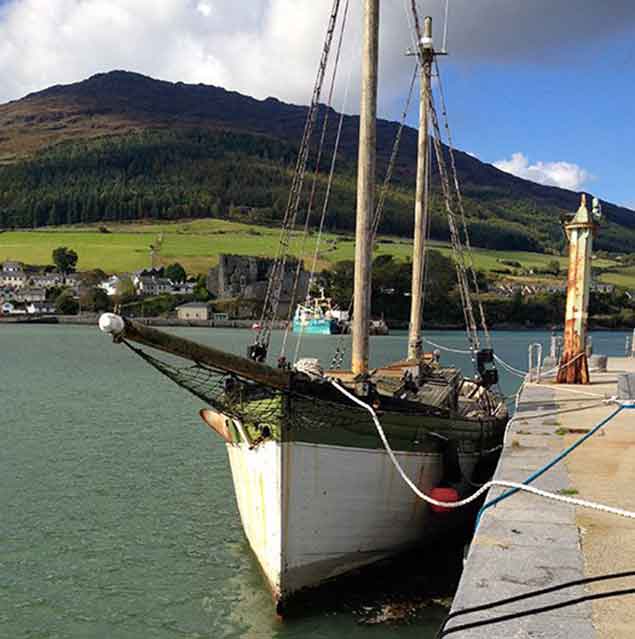 Dreamship? The characterful Silvery Light at Carlingford
Dreamship? The characterful Silvery Light at Carlingford
There’s a vessel called the Silvery Light in Newry, and she inspired those who saw her when she first arrived in Ireland alongside the quay in Carlingford. But now the owner seeks support from whatever source to make her fit to be a sail training vessel – we can only wait and see, for we have some idea of what a monumental task this is.
But in the little village of Portaferry, a tall ship dream has turned into disaster. We’ve carried stories of the sunken 130ft Regina Caelis on Afloat.ie in recent weeks, but things get no better.
Apparently she is owned by someone who bought her from a previous owner for just £1.The previous owner from Northern Ireland had bought her in Scotland, hoping to turn her into a tall ships dream to sail in warmer seas. But by the time he’d got her home to County Down, he realised it was beyond his ability to complete the work, so after he’d managed with great difficulty to get her berthed on the end of the little public quay at the south end of Portaferry, she was offered for sale for the nominal sum.
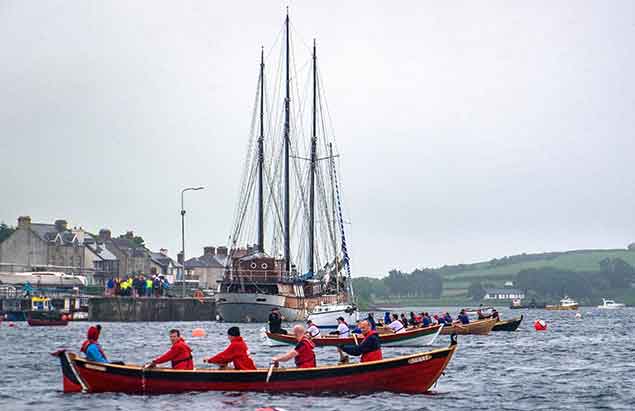 The elephant in the room, The 130ft Regina Caelis overstayed her welcome by many months when she effectively blocked off Cook Street Quay in Portaferry, making it difficult of access for the race officers in one of the local skiffie events, and unusable by any other boats…….Photo: Gary Lyons
The elephant in the room, The 130ft Regina Caelis overstayed her welcome by many months when she effectively blocked off Cook Street Quay in Portaferry, making it difficult of access for the race officers in one of the local skiffie events, and unusable by any other boats…….Photo: Gary Lyons
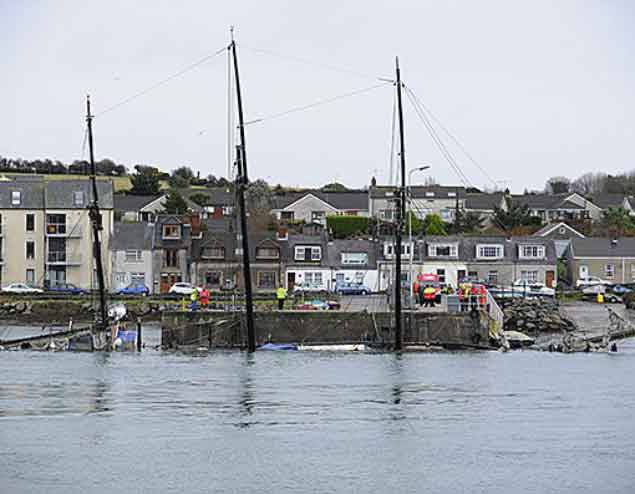 …….and then she went and sank, polluting Strangford Lough with 900 litres of diesel
…….and then she went and sank, polluting Strangford Lough with 900 litres of diesel
That was more than a year ago. Since then she has changed ownership for £1, but she continued to completely block off what should be an important local amenity, as Cook Street Quay – to give it its local name – traditionally provides free berthing, but its successful functioning depends on no-one abusing this valuable privilege.
Whatever about the good intentions when this ship the Regina Caelis arrived at the quay, berthed on it she is so out of scale that her bow sticks out at one end and her stern sticks out at the other, thereby impeding boat access to either side of a public pier. Staying there for more than a year soon became a matter of abusing a communal facility. But then it all became completely pear-shaped when she sank at the pier, gradually leaching 900 litres of diesel fuel into Strangford Lough, a very special nature reserve.
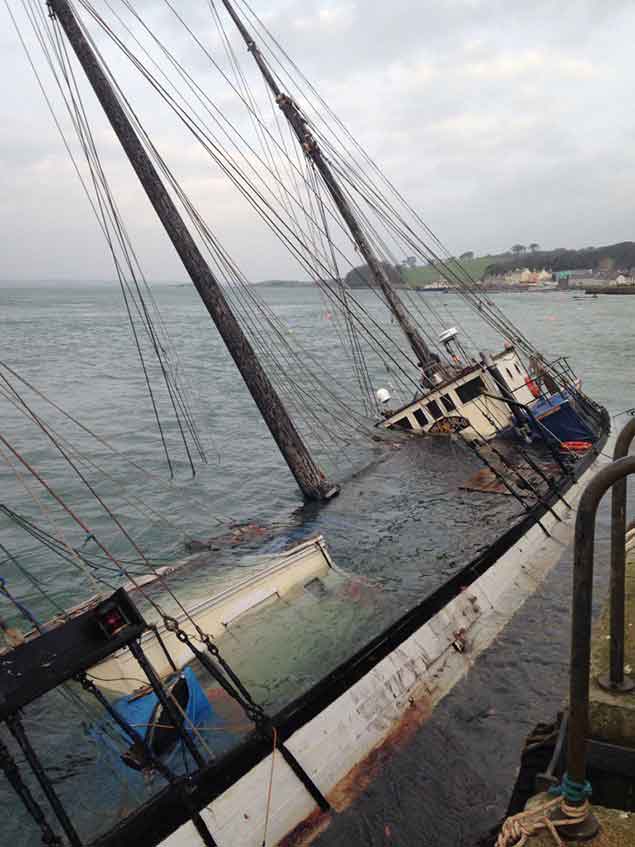 It would provide a perfect course in salvage techniques at some maritime university, but Portaferry could do without it
It would provide a perfect course in salvage techniques at some maritime university, but Portaferry could do without it
It’s now an environmental and neighbourhood disaster beyond belief. But with a free pier and in the absence of an active government, the position has been allowed to persist, while the optimistic owner has launched a crowd-funding initiative in order to raise his vessel and restore her to her full potential as a tall ship.
Seasoned observers reckon that it will indeed be a crowd-funding initiative which will solve the acute problem of the Regina Caelis slowly disintegrating at Cook Street Quay in Portaferry. But the crowd will be the much-put-upon taxpayers of Northern Ireland, and they’ll be in this crowd-funding project whether they want to or not.
Whatever the outcome, it’s all a very long way indeed from a properly researched and resourced sail training barquentine for the young people of all Ireland. And in its veiled hostility, it’s all an extremely long way away from the friendly efficiency of the annual Portaferry Sails and Sound music and traditional boat festival, which shows Portaferry at its best. In every way, it’s an excruciatingly unpleasant situation for a charming village. Portaferry deserves better.
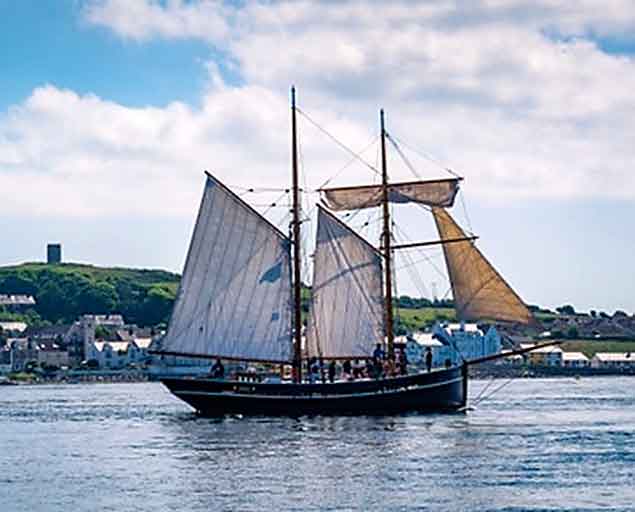 Portaferry in happier times, with Scott & Ruth Metcalf’s schooner Vilma off the town Photo: Neil Ritchie
Portaferry in happier times, with Scott & Ruth Metcalf’s schooner Vilma off the town Photo: Neil Ritchie
'Urgent' Assistance Sought to Raise Sunken Schooner in Portaferry
Afloat.ie has received an 'urgent' appeal for Tall Ship enthusiasts to help with a sunken 100–foot schooner in Portaferry Harbour. William Mulhall says he wants to return the 1935–built vessel to her 'former glory' but is seeking the assistance of a 'Tall Ship enthusiast to raise her and give her a refit'.
As Afloat.ie previously reported the schooner contained up to 1,000 litres of diesel fuel and had been moored in the harbour for some time, up to 18 months according to local reports.
BBC news says although a diesel spill in the area will clear up relatively quickly, the salvage operation to move the Regina Caelis could take months.
It is understood specialist equipment that is capable of bearing the weight of the boat, which is more than 200 tonnes, will need to be brought in.
Mulhall appealed for assistance via email: 'I have a tall ship sunk on the 27/1/17 in 20 foot of water still tied to the harbour and lying on her starboard side, in Portaferry, Co.Down, Northern Ireland
The Schooner Regina Caelis built in 1935 is 108ft long with a 40ft bow sprit and 10 sails, she has 3 masts and an engine BMA fitted in 1955.
I urgently need a Tall Ship enthusiast to raise her and give her a refit on slip and return her to former glory. I am open to ideas, partners, groups and shares'.
Contact details supplied : [email protected] or telephone at: 02844841301
Tall Ship Christian Radich Lights Up Cork City Quays
The Norwegian tall ship, Christian Radich, one year short of its 80th anniversary, made a fine sight in Cork city last night.
The 1937 built ship is berthed at the North Custom House Quay. As Afloat.ie previously reported, the visit to Cork Harbour is private and will run beyond the weekend to at least mid-week. This it to facilitate trainees who are to attend a maritime course.
Christian Radich is one of two of Norway’s most famous large tallships, the other ship been Statsraad Lehmkuhl dating to 1914.
The square-rigger in August made a visit to Dublin as part of National Heritage Week.
Narrow Margin Between Life And Death At Sea
Listening to a seafarer describe how colleagues from his native town left port on a night of very bad weather, when their Skipper was advised not to go by other Skippers, I thought of how there can be a very narrow margin between life and death.
Those men and their vessel never made it from the British coastline to Youghal in East Cork, which was once the biggest and busiest seaport in the Republic.
Youghal is a seaside town which has suffered heavily in recent years from recessionary impact and decline of industry in the area. Hundreds of jobs have been lost. It is a seaside town which, before the advent of cheap air travel to foreign locations, was a dominant holiday resort. It is where the famous ‘Moby Dick’ film was shot, chosen because of its maritime appearance. It is a town which is legendary for its schooners and schoonermen, trading from Ireland across the Irish Sea to the UK.
It is also where I present THIS ISLAND NATION radio programme on the town’s community radio station, CRY104FM, every Monday night ad from where it is also transmitted to other stations in Dublin, Dundalk, Athlone, Galway, Clare and Cork and here to the Afloat website. It is introduced with the theme music which caught the attention of listeners during my 20 years presenting SEASCAPES on RTE Radio, ‘Sailing By.’ This is the version of that tune played by another sailor, Ronnie Aldrich from the Isle of Man and his orchestra on his LP, ‘Sea Dreams.’ RTE dropped it as the programme’s theme tune after I left, but it is indelibly associated with the maritime sector, another version being used by BBC Radio for its late night sea area weather forecast, played by Ronald Binge and the BBC Light Orchestra. So I resurrected it for my new programme and it has again attracted considerable attention around the nation and abroad, where the programme is also transmitted through Mixcloud and Tune In Radio.
Listening to the interview of Pa Ahern, then an Able Seaman on another legendary Youghal vessel, the Kathleen and May, as we transmitted it, I heard him tell his story of sailing on that ship and how, when he went on board for the first time, he knelt down and kissed the wood of the ship: “I don’t know why I did it, I had it done before I knew it,” he told the interviewer, Noel Cronin, in a recording from the station’s archives. Pa is deceased but, through my headphones, his voice brought alive the scene he described on a night of very bad weather, when another Youghal schooner, the Nellie Fleming, sailed that fateful night and the five men crewing her, all from Youghal, died. Pa described how the Skipper of the Kathleen and May which he was aboard, also decided to sail, but the weather was so bad that a crewman told him he would kill them all and the Skipper turned the ship around and they headed back into port, which was a “tough struggle against the conditions”. Pa been put to watching for navigation lights and described how he saw a ship in the distance in high seas driven by gale force winds, with lashing rain. “It had lost a mast, but I am sure it was the Nellie Fleming…” It was the last sight anyone saw of that vessel, which is the subject of a new book by Youghal historian and author, Mike Hackett, called ‘Lost Without Trace”. The old sailing ships were tough, demanding vessels and could be dangerous in difficult weather. There were some which did not survive. One was the Nellie Fleming, lost coincidentally in the same month of February 1936 when another major maritime event occurred on the East Cork coastline, not far from Youghal.
This was the rescue of the Daunt Rock Lightvesel crew after it broke from its moorings at the entrance to Cork Harbour. This week is the anniversary of that rescue, still regarded as the most famous in Irish lifeboat history. It was carried out by the Ballycotton Life crew under legendary Coxswain Patsy Sliney and they were all awarded medals for their courage. Unusually, so was their boat - the Mary Stanford - now ashore on permanent display in the East Cork coastal village and worth a visit if you are ever in that area.
Mike Hackett’s book tells that the Fleming family which owned the ill-fated Nellie Fleming had lost their original ‘Nellie Fleming’ vessel when it went aground at Ardmore in 1913. All the crew were saved from that shipwreck. Then, in 1916, Fleming’s purchased a vessel named ‘Emily’. It had been built at Carrickfergus in 1884. The name was changed to ‘Nellie Fleming’ and she was registered at Cork.
The Kathleen and May is the last remaining British-built wooden hull three-masted topsail schooner. Registered in Bideford, North Devon, there have been several attempts to restore and preserve her. Last heard of she was based in Liverpool and listed as part of the UK National Historic Fleet.
How did the Kathleen and May get back into port safely that bad February night? Pat Ahern said it had an engine: “Without it we would never have got back.”
These stories underline for me how narrow is the margin between life-and-death.
• Listen above to the programme on the Afloat website
No Tall Tales – There Will Be An Irish Tall Ship
“Behold the turtle who makes progress, but only when it sticks its neck out.”
I like that quotation because I have ‘stuck my neck out” several times in reporting on the marine sphere.
I am doing so again now.
To judge from comments I had received, there was cynicism and doubt about the likelihood of success being achieved by what was previously known as the ‘Pride of Ireland Trust’ and is now the ‘Atlantic Youth Trust,’ in its attempts to build a new Irish tall ship.
I had doubts myself, but at the annual general meeting of the AYT I was impressed by the quality of those present and their commitment to sail training. There was a determination that there will be a new Tall Ship to replace Asgard II, within a target of three years, “to provide opportunities to young people on the island and to meet the forecasted and growing demand” for sail training.
That is what the AYT has decided as its parameters for the new vessel:
* Steel hull
* Under 50 metres
* Less than 500 gross tonnes
* Less than 4m draught
* Low maintenance
* SOLAS Passenger Ship regulations, Load Line, MARPOL and MLC to be complied with
* 7/8 permanent crew, 4/5 volunteers (classed as passengers), 40 young trainees (classed as passengers).
Those were the descriptions given to the agm of the Trust held at the offices of Irish Lights in Dun Laoghaire, where I was also pleased to note the close interaction between those who lead Sail Training Ireland and the Atlantic Youth Trust.

Neil O'Hagan of the AYT
In my AFLOAT PODCAST (above) this week you can hear my interview with Neil O’Hagan, Director of the Trust, who tells me that, once money committed by the Government is made available, the building programme can be triggered, with a three-year time span to complete.
That financial commitment was contained in the Government’s Capital Programme and the Northern Ireland Government has also committed funding to this All-Ireland project, the total cost of which is likely to top out at around €16m.
I am a wary person where politicians and their promises are concerned, but inclusion in the Capital Programme is a statement of intent which, even post-General Election should be honoured. Beware however, the influence of the Civil Service which has often not shown itself to be a true maritime friend. But the Government owes €3.8m. at least in the insurance compensation it pocketed for Asgard, due to that Limerickman, Willie O’Dea, who showed no understanding of the importance of Asgard. In my view he dishonoured the name and legend of history of the maritime association with the foundation of this State. In this centenary year of commemoration indeed, would there have been an Easter Rising without the contribution to the resources of the Volunteers by Asgard 1’s historic involvement?
I have not seen any politician so far refer to that in the commemorations up to now.
I stuck my neck out before in support for the Jeanie Johnston, a project much-criticised by people ignorant of the achievements of that cross-Border project; of how it united young people and, built from scratch in Ireland, sailed successfully throughout Europe, to the U.S.A., Canada and Newfoundland as an impressive ambassador for Ireland.
There is more hope now for a new Tall Ship for Ireland…….
As surely as the turtle makes progress, even if slowly, so will this project for which I, like the turtle, am sticking my neck out in support.
More on the new Tall Ship from WM Nixon here
High Hopes for Ireland's Tall Ship – The Force is With Them
The governments in both jurisdictions in Ireland have included an all-Ireland sail training ship for the Atlantic Youth Trust in their long term capital expenditure proposals. And the movement in favour of support for this project has become so strong that the nationwide team involved in promoting it are confident that the ship’s future is now secured.
They continue to hold this view even with general elections and possible major changes in administrative direction taking place, north and south, within the next four months. Thus this week’s 2016 Annual General Meeting of the Atlantic Youth Trust in Irish Lights Headquarters in Dun Laoghaire found itself reviewing a remarkable year of progress and achievement, while giving pointers and reassurances for the successful way ahead. W M Nixon was there to take on board an evening of multiple messages.
It could well be that some time in the future, we will come to the sad but inescapable conclusion that the foundering of the Republic of Ireland’s national 84–ft sail training brigantine Asgard II in September 1908, followed within two years by the sinking of the Northern Ireland 70ft training ketch Lord Rank, were necessary disasters for the progress towards the ultimately more healthy ideal of a Class A 40-metre sail training barquentine.
The proposed ship - determinedly and enthusiastically serving all Ireland – will be initially funded through donations, and by government grants from both sides of the border. But the vessel is to be run independently by a cross-border trust rather than by some obscure unit of a government department.
September 2008 saw Ireland on the edge of the financial abyss. For a government under enormous pressure from all sides, a government, moreover, in which the minister responsible for the Asgard II took little or no interest in the ship and what she did, this sinking was a blessing in disguise.
The hull of Asgard II, completed in 1981, had long passed its sell-by date. When she sank, she took with her the magnificent rig which had been totally replaced only a couple of years earlier. Yet a properly involved government would surely have taken on board the advice that her timber hull urgently needed replacing, preferably with one built in steel. For although in 2008 the ship looked better than ever thanks to the devotion of her crew in working way over and above the call of duty in painting, varnishing and routine maintenance, there was no escaping the fact that the basic hull and its original fittings were living on borrowed time.
Ironically, the visit to La Rochelle, which she was nearing when she sank, included plans for a three-week stopover for a complete survey and some necessary repairs. Whether or not this would have revealed the fracturing seacock which many reckon to have caused the unstoppable ingress of water can only be a matter of speculation. The fact of the matter is the ship sank, and in an exemplary display of seamanship, the captain and crew ensured that their full quota of young trainees got safely away.

Flying the flag for Ireland – Asgard II in fine form, seen from another tall ship
But although Asgard II remained stubbornly intact and upright for some weeks on the Bay of Biscay seabed off Belle Ile, a government with financial Armageddon crashing down around its ears was glad enough to be shot of a unique project which some of them had never really understood or supported in the first place. Thus they refused to consider multiple suggests as to how best Asgard II could be salvaged. And frankly, it was for the best that they did so. For like it or not, while she was much-loved by the maritime community, the vessel had lost public confidence.
The subsequent loss of the Lord Rank in July 2010 after striking a rock likewise resulted in a merciful absence of casualties. But with Ireland north and south now in the utter depths of economic recession with no governmental enthusiasm whatsoever for non-essential projects, it was time to re-group for a few years and re-think the entire sail training ideal. It became almost an underground movement, with Coiste an Asgard being re-structured as Sail Training Ireland, and diligently setting about placing Irish trainees on the ships of other nations. It’s an ongoing programme which has been notably successful in providing both sea-going experience and a guaranteed international dimension for young people from all over Ireland, city and country alike.
Meanwhile there were rumblings from the west of Ireland where Enda O'Coineen and John Killeen were building on the can-do attitude of Galway, and from this there gradually emerged the Atlantic Youth Trust. It’s a determinedly all-Ireland group in which the Chairman is former Winter Olympics Gold Medallist Lord Glentoran from Northern Ireland, with the unstoppable unsinkable O Coineen as President. Supporting them is one very impressive list of seriously heavy hitters in the maritime and big business sphere from all over Ireland on its board, and perhaps most importantly of all, at an early stage they secured Neil O’Hagan as Executive Director.

Neil O’Hagan, Executive Director of the Atlantic Youth Trust
This sounds an impressive title, but at the moment he heads up a minimal staff. You can get the flavour of it all by taking a look at the Sailing on Saturdays conversation I had with him, reported here on 4th April 2015. The amount of work he puts in is prodigious, and though the Trust’s founding General Meeting was held in Belfast in the Harbour Commission’s historic building on September 10th 2014, they’d to forego a General Meeting during 2015 while various elements and agreements were being finally edged into place.
Since April 2015 we’ve had snippets of news about the governments north and south starting to provide what are essentially government letters of intent in support of the project. However, politics on this island being a snakelike progression notwithstanding the best efforts of St Patrick, with every twist and turn of the political machines the AYT have been at pains to ensure that gains supposedly agreed by one administrative decision-maker are carried through into the remit of the next when the inevitable political wheel of fortune turns yet again at the individual level.
But now, with two general elections in the offing and a rapidly improving situation developing in the AYT’s prospects, it was essential for a properly-convened AGM to be held on Thursday January 21st, staged this time in the impressive board-room of the Irish Lights Commissioners in Dun Laoghaire.

The boardroom at Irish Lights HQ is an impressive venue for any meeting, and it suited the Atlantic Youth Trust’s 2016 AGM very well
 The maritime evangelist……Enda O'Coineen in full flight at this weeks AGM of the Atlantc Youth Trust
The maritime evangelist……Enda O'Coineen in full flight at this weeks AGM of the Atlantc Youth Trust
Ironically, although one of the main lines of thought in the AYT’s thinking is that the ship they’ll provide will be more of a floating multi-discipline schoolship of many projects, both afloat and ashore, rather than a traditional sail training ship, it emerged at the AGM that it was the traditional Tall Ships visit and Parade of Sail in Belfast and on Belfast Lough last July which gave them their greatest boost.
They’d a significant presence there, and thanks to one of the Trust Board Members, they’d the use of a fine big motor vessel aboard which visiting politicos and other heavy hitters could be taken on a sociable yet instructive tour of the harbour and the Tall Ships fleet. For many of these decision makers and opinion formers, it was a transformative experience, turning them into supporters of the Atlantic Youth Trust’s way of thinking.
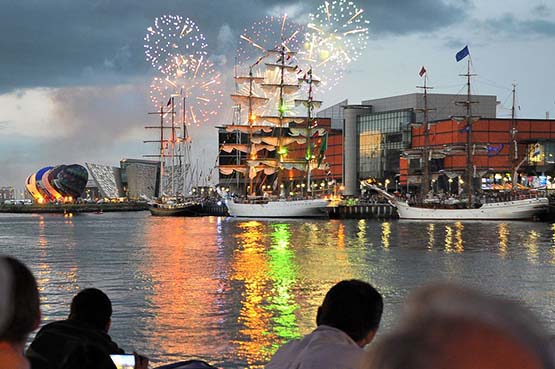
The Tall Ships in Belfast, July 2015
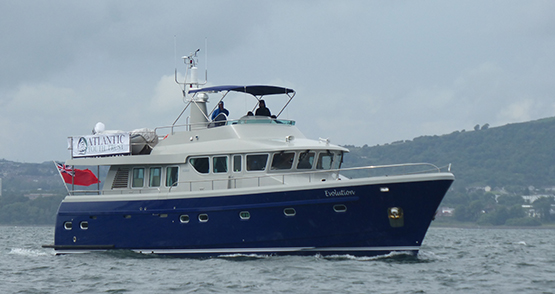
This opened doors north and south, and they rapidly increased their already formidable knowledge of how to work the corridors of power. The meeting on Thursday in Irish Lights was chaired by Peter Cooke from the north, and his affable presence made the running of business very smooth indeed. But as each specialist on the board revealed the progress they’d made during the past year and more in their particular task, it was to realize that here were people who were utterly professional in their approach, yet went at the job with the total enthusiasm of dedicated amateurs.
But what most impressed was the synergy of the high octane talents on the board which, in addition to Lord Glentoran, Enda O Coineen and Peter Cooke, can draw on the talents of people of the calibre of Dr Gerard O’Hare, Roger Courtney, Sean Lemass, David Beattie and John Killeen – with Neil O’Hagan as the key conduit, they’ve turned themselves into a formidable lobbying organisation.
It’s a fact of life in all Irish political administration, and particularly in Dublin, that each separate government department much prefers to function independently within its own little bubble, with nothing whatever to do with any other department while avoiding overlaps if at all possible. This is especially so in the neglected area of maritime activity, which is overseen by several departments, and is further warped by the reality that the government is in Dublin - which is also the biggest port - yet the real scene of the maritime action and the true hotbed of ideas is Cork.
So our shrewd operators in the AYT stood back and concluded that the politician they should most directly target was of course Minister for the Marine (and many other matters) Simon Coveney TD of Cork, but that in Dublin the departments to be wooed were Finance and the Office of the Taoiseach.
With increasing support at official level in the north and enthusiasm from key decision makers in the Republic, things were going grand when the President of the AYT suddenly went off in December 2015 to race single-handed across the Atlantic from the Caribbean to Brittany in his IMOCA 60 Kilcullen Voyager. Enda O’Coineen’s big boat has been very much part of the AYT awareness programme for the past year, taking trainee crews to sea. But this was something else altogether, and it made many supporters of the new training ship ideal distinctly nervous.
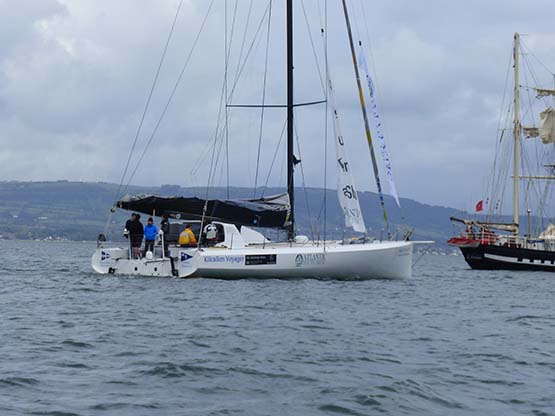
Racing across the Atlantic in as rough a December as anyone could remember may have been a personal challenge, but inevitably it was a high risk venture with which the AYT was inevitably associated, whether it liked it or not. The sailing community in Ireland is small, and nothing can happen in isolation. But to everyone’s enormous relief, not only did the boy do it, but he did it well, sailing across in style and securing a podium place with third at the finish.
This was quietly acknowledged as something which had been on everyone’s mind in a graceful little speech by the Deputy Chairman of the Irish Lights Commissioners congratulating the President on his Transatlantic success. So with everything in place as regards where AYT now stands in relation to both governments, the formal part of the meeting concluded with some commitments as to the way ahead, and the news that the Atlantic Youth Trust’s next public gathering of significance will be in Galway on March 12th, when more precise details of the new ship and the building programme will be revealed.
However, with an ethos in which going the extra mile is part of the DNA, the AYT then laid on a hugely entertaining dinner in the neighbouring Royal Irish YC with fascinating shows by the Gardai Siochana’s Conor O’Byrne, who played a central on-board co-ordination role in rescuing a crewman who had gone overboard in mid-Pacific from the Clipper yacht Derry-Londonderry-Doire, and from Stewart Hosford from Cork, who is CEO of the organisation Five Degrees West whose main project is the designing, building and management of the Imoca 60 boats raced under the Hugo Boss campaign by Alex Thompson.
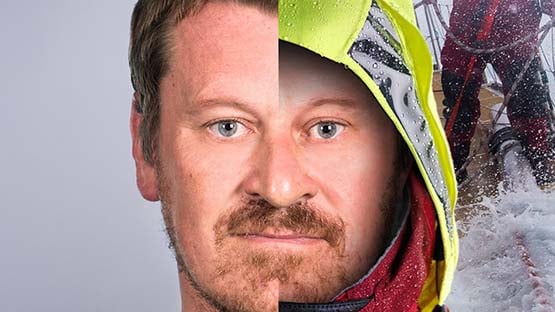 May The Force Be With You – the two faces of the Garda Siochana’s Conor O’Byrne, who gave the AYT and its supporters a fascinating insight into the successful rescue of a crewmember who went overboard from Derry/Londonderry/Doire in mid-Pacific.
May The Force Be With You – the two faces of the Garda Siochana’s Conor O’Byrne, who gave the AYT and its supporters a fascinating insight into the successful rescue of a crewmember who went overboard from Derry/Londonderry/Doire in mid-Pacific.
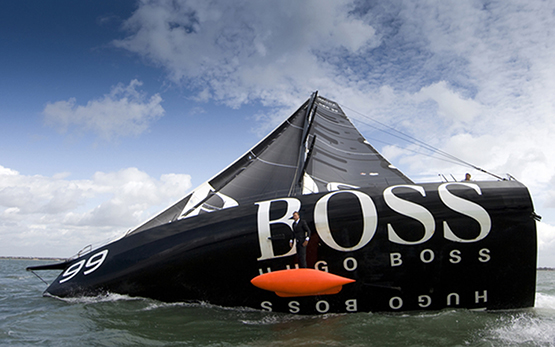 Suits you, Sir…..Alex Thompson on the second Hugo Boss. At Thursday’s meeting, Stewart Hosford of Cork – whose interest in the sea and sailing was inspired by Asgard II – gave the inside story on his job as CEO of the Hugo Boss sailing challenges.
Suits you, Sir…..Alex Thompson on the second Hugo Boss. At Thursday’s meeting, Stewart Hosford of Cork – whose interest in the sea and sailing was inspired by Asgard II – gave the inside story on his job as CEO of the Hugo Boss sailing challenges.
Each compact yet thought-provoking show would have made for a worthy topic on its own in most clubs’ entertainment programme. But it was special to include both on this night of all nights, as each speaker had been enthused in their youth by sailing on Asgard II, and each would do anything to ensure that the upcoming generations get a similar opportunity and inspiration.
It was that kind of night, with the congenial attendance including Seamus McLoughlin and Michael Byrne from Sail Training Ireland, and Oliver Hart whose 70ft schooner Spirit of Oysterhaven continues gallantly to fulfill the role of Ireland’s premier sail training vessel from her base on the Cork coast.
In all, it’s a busy few days for Irish sail training, which is definitely no longer an underground movement. Today, Sail Training Ireland hold their 4th Annual Prize Giving and Programme Launch in the Mansion House in Dublin, looking back on a season in which the number of funded trainees sent on sailing ships abroad and at home came in at just under 300, while in all they arranged berths for more than 500.
The plan for 2016 includes a formal twinning of Dublin and Liverpool for maritime festivals, while on the training front, STI are aiming for a target of 350 funded trainees. And as for Ireland eventually returning to having her own sail training ship, no sooner was Thursday night’s remarkable series of events brought to a close than Neil O’Hagan had to gather his thoughts and head off for New York to meet the Ireland Fund. They are taking a serious and very positive interest in the plans of the Atlantic Youth Trust.

Tall Ship The Hermione, the authentic replica of the 18th century ship the Marquis de Lafayette, makes the ideal subject for this aerial video shot by Nautimages during the replica's stopover in Brest, four months ago.
The French 12-pounder frigate Hermione was famous for her support of America during the Revolutionary War. She sailed to the America’s with news of full French support for the cause.
Her 1997-built replica is famous for being a gorgeously-built copy of an archetypal combatant during the Age of Sail.
Last year, the replica lead a Parade of private and commercial ships up the Hudson River on July 4th. More on her here




























